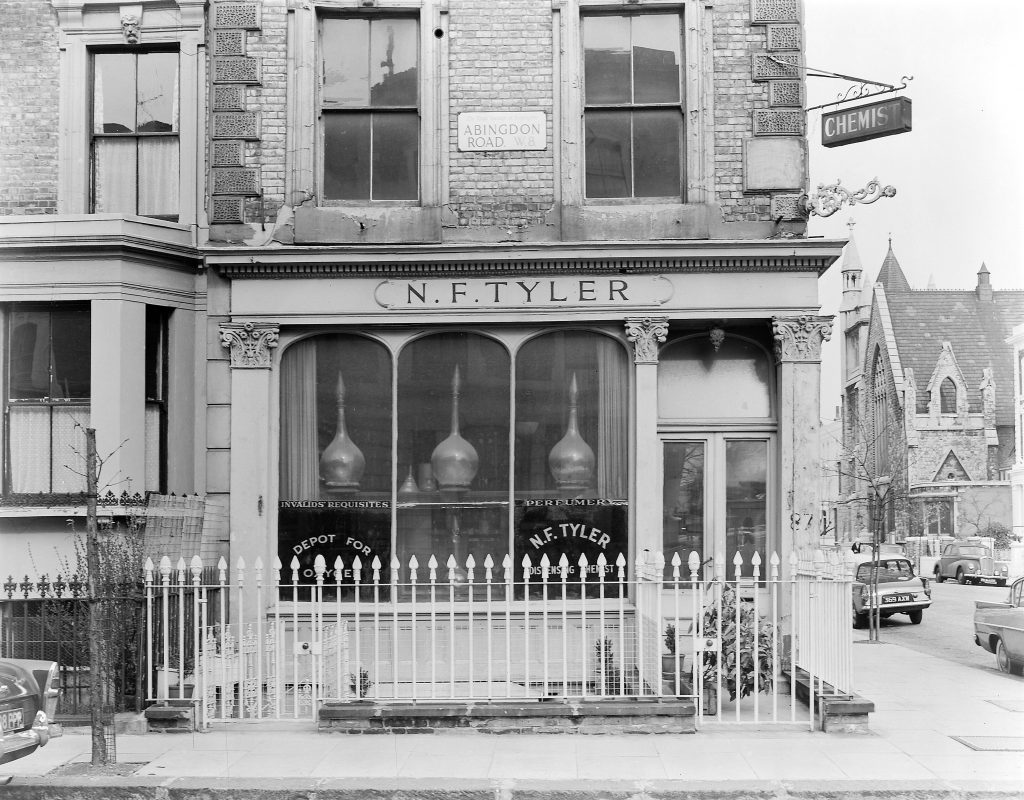My role in the One Collection project involves encounters with hundreds of objects of all kinds. In the pharmaceutical glassware collections, I recognised the address of a chemist on the labels of several jars and bottles: N.F. Tyler, 87 Abingdon Road, Kensington W8, a mile or so from Blythe House.

Through my interest in fashion history, I knew the address was also once home to the original Biba boutique. Biba was well-known in swinging sixties Britain for providing affordable fashion to a generation with big spending power and a fresh take on style that marked them out from their parents.
In September 1964, Biba’s creator Barbara Hulanicki opened her first boutique. The shop had previously been a chemist’s, left empty for many years. Photos of the original interior show a Victorian pharmacy similar to the one recreated in the Science Museum’s Medicine: The Wellcome Galleries, with dark wood fittings and large glass carboys in the windows, typical of the Victorian shop-front style.

Unlike the mod and pop art styles popular in other new boutiques of the time, she inventively drew on the shop’s old-world feel. Predating later trends for Victoriana and eclecticism in design, the interior had William Morris curtains, potted palms and antique bentwood hat stands used as clothes rails; all while The Rolling Stones and The Beatles records blasted out to entice customers in search of cheap, flashy new clothes. This unique combination of old and new attracted hundreds of shoppers each week.

Hulanicki pioneered the concept of retailers having a bold, but consistent, brand identity. She embraced a largely subdued colour palette, including chocolate brown, moss green, burgundy and gold, that highlighted the old-fashioned style of the store and the subversively new items its patrons wore. Inspiration for beauty product packaging came from old medicine and poison bottles, as the former chemist would have stocked, and Hulanicki found an original Victorian bottle mould at a makers’ works, which was used to create new bottles.

Historically, poison bottles had been designed with ridges on to stop them being mistaken for normal medicines, but for Biba’s beauty range, this design element was purely decorative rather than a safety feature. The Science Museum’s collection contains many examples of historic medicine and poison bottles in different colours and sizes.

Outgrowing its location in 1966, Biba would have three more homes in Kensington, and the clothes would become further influenced by the Victorian era, as well as the 1920s, ‘30s and ‘40s. The final store, Big Biba, (above High Street Kensington station) was the culmination of Hulanicki’s vision of retail as a luxurious leisure experience.

Biba was over in 1975, after a takeover by British Land saw Hulanicki forced out. But Biba is fondly remembered by fashionistas and its legacy lives on, from retailers like Liberty that embrace their old-world façade to imbue their wares with a sense of heritage, to designers like Vivienne Westwood who mix the subversive with the familiar.
Creating a distinctive aesthetic while promoting glamour on a budget, Barbara Hulanicki set the course for contemporary retail and branding as we know it today, and it had all begun in a humble old pharmacy.
The One Collection project will see N.F. Tyler’s glassware and thousands of other objects moved away from Kensington to their new home at the National Collections Centre in Wroughton, Wiltshire, and as Decant Assistants, we will ensure their safe packing ready for travel. The Victoria & Albert Museum’s collection of Biba items and archives will also be moving from Blythe House, to the V&A East, Stratford.
With thanks to Adam Keppel and Steven Thomas.
One comment on “From the Chemist’s on the corner to the Biba Boutique”
Comments are closed.
Interesting to draw a link between the two subjects. And – as my TV keeps informing me at this time of year – there’s a brand of perfume by Dior called ‘Poison’.